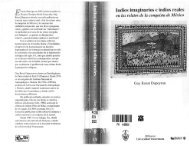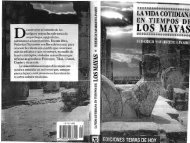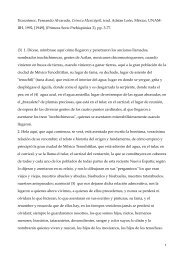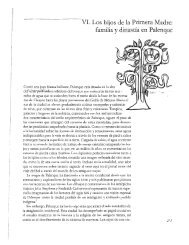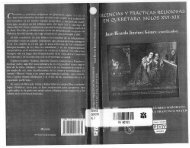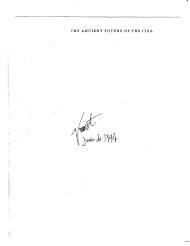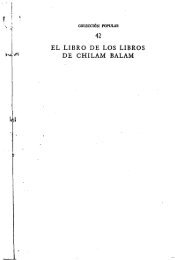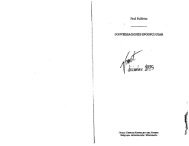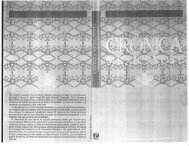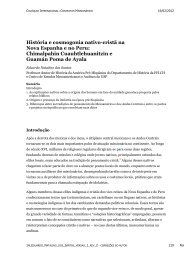HEAVEN BORN MERIDA AND ITS DESTINY - Histomesoamericana
HEAVEN BORN MERIDA AND ITS DESTINY - Histomesoamericana
HEAVEN BORN MERIDA AND ITS DESTINY - Histomesoamericana
Create successful ePaper yourself
Turn your PDF publications into a flip-book with our unique Google optimized e-Paper software.
40 INTRODUCTION<br />
shuffled. Atikuhe also seated this katun, and heart sacrifices are mentioned<br />
for 1485 in connection with the calendar round ceremonies (Oc<br />
Na) at Mayapan. Although Mayapan had already fallen, it was not until<br />
this katun that it was destroyed, according to the Tizimin.<br />
Sixteenth Century. Katun 2 Ahau opened in 1500 with a great hurricane<br />
and fire, and in 1516 there was a plague. The latter, tersely described as a<br />
fever [kakil), may have been a consequence of the first contacts with the<br />
Spaniards. The celebrated encounter between Columbus and a boatload of<br />
Maya on the high seas in the preceding katun is not mentioned in any of<br />
the Books. But Spanish entradas began in earnest in 2 Ahau: Aguilar in<br />
1507, Valdivia in 1511, Ponce de León in 1513, Córdoba in 1517, Grijalva<br />
in 1518, and Cortés in 1519. The arrival of Ponce de León appears to be<br />
recognized and correctly dated in line 140. Other apparent references to<br />
dates in this katun are, however, erroneous because they are stated in the<br />
Valladolid calendar: when corrected they prove to be later. The katun was<br />
seated at Chacal Na and also at Cozumel. The sermon of the katun by its<br />
Spokesman, Puc Tun, is brief and vague, but dire.<br />
The final katun in the Itza may, 13 Ahau, was a turbulent and eventful<br />
period. At least four towns (Cozumel, Kin Colah Peten, Euan, and Coba)<br />
tried to seat the katun, clear enough evidence of the continuing chaos left<br />
by the fall of Mayapan. The sermon of the Spokesman, Xopan Nahuat,<br />
predicts the imminent arrival of the Spaniards (no great trick, as they had<br />
already arrived) and attempts to relate it to the origin myth of the Xiu,<br />
"The Birth of the Flowers."<br />
In 1526 Francisco de Montejo landed on the east coast with the intent<br />
of initiating the long, hard conquest of Yucatan. Three years later a new<br />
calendar round began, coinciding with the mid-katun ceremonies and further<br />
exacerbating the political troubles, since this was the moment for<br />
designating the Jaguar for the next katun.<br />
Matters came to a head in 1536. Because of a drought in the province of<br />
Tutul Xiu (according to the Mani), the governor of Mani, Pot Xiu, decided<br />
to lead a water pilgrimage to Chichen Itza. He was accompanied by his<br />
lieutenant, Kin Chi, and eleven other lords from adjacent towns: Iban<br />
Can of Telcit, Pa Cab of Oxkutzcab, Kan Caba of Panabchen, Ku Pul of<br />
Sacalum, Nahuat of Teabo, Ul Uac Chan of Cauich, Zon Ceh of P'en<br />
Cuyut, Ahau Tuyu of Muna, Xulcum Che of Tipikal, Tu Cuch of Mama,<br />
and Zit Couat of Chumayel. As a water priest {pul ha) and as a pilgrim,<br />
Pot Xiu (and his companions) should have been secure enough, and he had<br />
been assured of a safe-conduct by Chi Cocom, governor of Otzmal. However,<br />
when they reached Otzmal, the whole party was seized and murdered.<br />
This was on February 2, 1536 (Craine and Reindorp 1979: 77, note<br />
60). The Mayan date was a calculated insult. It fell on 9 Imix, the day<br />
after 8 Ahau, the traditional end of the Xiu cycle, and hence it was a direct<br />
assertion of the Itza intention of seating their own cycle, which they<br />
did, three years later.<br />
It must be remembered too that the Spanish had reached Campeche the<br />
year before and that Pot Xiu's father, Tutul Xiu, was their first important<br />
convert. He had even headed a delegation of most of these same lords to<br />



